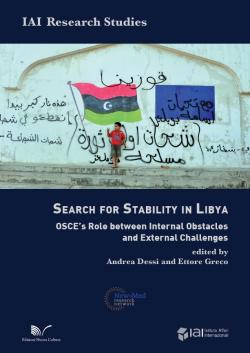The Search for Stability in Libya. OSCE's Role between Internal Obstacles and External Challenges
This volume examines the goals and prospects of the OSCE’s growing engagement in the Mediterranean region and, more specifically, with the OSCE’s six Mediterranean Partners for Cooperation (Algeria, Egypt, Israel, Jordan, Morocco and Tunisia). The volume’s four chapters focus on the OSCE’s potential role in international efforts to stabilize Libya, a country which has been ravaged by a prolonged and destructive civil war, becoming the epicentre of conflict dynamics with far-reaching implications for both neighbouring countries and Europe. Each chapter addresses a particular theme, or level of analysis, tied to the current conflict in Libya. Beginning with an introductory chapter outlining the OSCE’s growing engagements in the Mediterranean region and Libya’s abortive requests to joint the OSCE Mediterranean Partnership, subsequent chapters delve into the minute details of the major internal and external obstacles to peace-building and stabilization in Libya, addressing the role of regional, European and international actors involved in the country. A final chapter delivers a Russian viewpoint of these themes and traces Moscow’s evolving policy and interests in Libya while addressing the broader role of the OSCE in the Mediterranean.
-
Details
Rome, Nuova Cultura, May 2018, 111 p. -
Issue
1 -
ISBN/ISSN/DOI:
978-88-3365-060-9
List of Contributors, p. 7
List of Abbreviations, p. 9-10
Foreword, by Ettore Greco and Nicolò Russo Perez, p. 11-13
1. The OSCE Mediterranean Partnership, Libya and the MENA Crisis: Potential, Limits and Prospects, by Andrea Dessì, p. 15-45
1.1 The OSCE area and outlaying regions: An evolving relationship
1.1.1 The OSCE Mediterranean Partnership for Cooperation
1.2 Post-2011 OSCE Mediterranean engagements and the crisis in Libya
1.3 A Helsinki-like process for the Mediterranean?
1.4 Fostering the OSCE’s Mediterranean role and the question of Libya
2. The Libyan Crisis: Internal Barriers to Conflict Resolution and the Role of Multilateral Cooperation, by Mohamed Eljarh, p. 47-66
2.1 The path to failed state in Libya
2.1.1 Libya’s hastened return to elections
2.2 The Skhirat Agreement: key actors and failures
2.2.1 Foreign meddling in Libya
2.3 Barriers to the implementation of the Skhirat Agreement
2.3.1 Internal barriers
2.3.2 External barriers
2.4 Conclusion
3. External Actors in Libya: International Organizations at Odds with Global and Regional Players, by Wolfgang Mühlberger, p. 67-88
3.1 Fragmented statehood: Libya’s brittle structures torn apart
3.2 Libya divided: external players between diplomacy and military logic
3.2.1 International and regional organizations: the fragmentation of diplomacy
3.2.2 Immediate Arab neighbours: positions from non-intervention to proxy warfare
3.2.3 The wider Middle East: clashing geopolitical ambitions
3.2.4 European involvement: shared vision, different approaches
3.2.5 International and global players: potential post-Cold War frictions over Libya
3.3 Negotiating peace: the UN-led process and ancillary tracks
3.4 Conclusion
4. Russia’s Approach to the Conflict in Libya, the East-West Dimension and the Role of the OSCE, by Ekaterina Stepanova, p. 89-111
4.1 Russia’s policy on the Libyan crisis
4.1.1 Background
4.1.2 Russia and Haftar: security and counterterrorism
4.1.3 From counterterrorism to peacemaking: Russia as a facilitator of intra-Libyan dialogue?
4.2 Russia and multilateral cooperation on Libya: a role for the OSCE?
4.2.1 The East-West dimension
4.2.2 The North-South/Mediterranean dimension
4.3 In lieu of conclusion: Russia, the OSCE and Libya
Topic
Tag
Related content
-
Event17/09/2018
Crisi libica: sviluppi recenti e prospettive di soluzione
leggi tutto -
Ricerca09/10/2014
New-Med Research Network: The Future of Cooperation in the Mediterranean
leggi tutto



